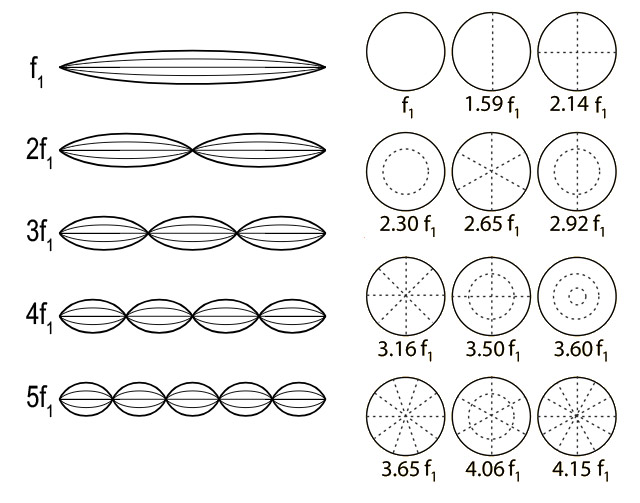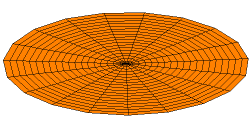Drum sound
 Through the years of playing drums, I've just been winging it with drum tuning until I have a decent sound. So I thought I'd try to really understand how this works, to be able to reliably create a great drum sound.
Through the years of playing drums, I've just been winging it with drum tuning until I have a decent sound. So I thought I'd try to really understand how this works, to be able to reliably create a great drum sound.
It turns out that it is very complicated, and there isn't much science around this. There is plenty of advice and demonstrations on YouTube and elsewhere on the internet. Even from professional drum techs and top level drummers, the advice is mostly pragmatic; "do like this until it sounds good".
After extensive reading, watching videos and hands on tweaking on my own kits, here are my thoughts on the subject.
Factors that affect the sound
Here are the factors that affect the sound for a given problem free tom-tom. Below I will try to explain each factor and how it relates to the sound of the drum.
- The tuning - To what pitch the two drum heads are tuned, and how well it is done
- The drum head - How thick the head is and its type
- The drum mount - How much it allows free vibration of the drum shell
- The drum stick - The shape and material of the tip, the overall length and weight of the stick
Factors that have little to no sound influence
- The hoop - Changes the resonance pitch slightly, also possibly makes it easier to tune
- The bearing edge - Can influence overtones slightly
- The drum shell depth - In most cases have very little effect
- The drum shell thickness - Other than changing the resonance pitch, thicker shells might improve sound projection slightly
- The drum shell material - Most people can't pass a blind test between different shell materials. Even plastic/acrylic drums can be tuned to sound exactly like drums made of wood.
Drum tuning
Why is tuning a drum so much harder than tuning a guitar? A string on a guitar vibrates in one dimension, while a drum head vibrates in two dimensions.
Below: The left column shows a vibrating guitar string. The fundamental pitch f1, is the note that the string is tuned to, for example an A at 440 Hz. The overtones 2f1, 3f1, etc, are true harmonics, i.e. they are multiples of the fundamental pitch. The combination of the fundamental pitch and overtones at different volumes create the timbre, or "tone quality" that makes it sound like a guitar. The right column shows a drum head and a few of the different ways it can vibrate. Adjacent areas move up and down in different directions. A drum also has a fundamental pitch f1, although not as easy to hear as a guitar string.

The overtones that make up the timbre of the guitar sound are true harmonics and relatively low in volume, while the drum overtones are high in volume and not true harmonics. This makes our ears perceive a drum as mostly percussive and a guitar as mostly melodic.

Here is an animation of one of the ways a drum head can resonate, and a video captured by a a high speed camera.

The simpler the drum head resonates, the less overtones the sound contains, and the more "pure" and pleasing it will sound. Many factors affect this resonance: what point the stick hits, how the two drum heads are tuned, what type of drum heads, and more.
So what tuning method can be used to get a pleasing sound? Since drum physics is so complicated, there is no really clear answer, even among the best drum techs. It seems like many of them learned the trade through trial and error, spending countless hours turning the tension rods until they developed an intuition for what works. I've heard no one describing a fool proof way of tuning drums; it always contains some element of "tweaking until it sounds good". Because of the resonance complexity, a drum that is technically out of tune can still sound great. But it still pays off to use certain methods, because they are more reliable, instead of randomly fiddling around.
Resonance and pitch
There are some things that can be good to know before you start tuning.
- Maximum resonance happens when both drum heads are tuned to the same pitch and when that pitch is close to the shell's resonance pitch. This is when the sound energy has the least resistance, and the tone will have the highest volume and sustain (length). The shell resonance is hard to measure, but when you tune the drum you will notice that near a certain pitch the drum is "opened up" so it sounds louder and clearer.
- In the case the drum heads have different pitch, the overall pitch of the drum is affected by the pitch of both drum heads, but never the same as either of them. The higher pitched head (no matter if it is the batter or resonant head) has the most influence over the drum pitch and affects the tone mostly in the beginning of the sound (when the drum has just been hit). The lower pitched head affects the tone in end of the sound, making it dip down in pitch.
- Muffling the opposite head kills the fundamental pitch of the current head. This is because the fundamental pitch moves the entire head up and down, which is only possible when the air can push the other head to move. Now only overtones are audible. The lowest possible overtone can be found when hitting between the center and bearing edge of the head, and it has 1.6 to 1.9 times the frequency of the fundamental.
Tuning procedures
After watching countless videos, and through my own experience over the years, here is my take on the typical procedures:
Step 1: Mount the drum head
Prepare the head by making sure the rim is evenly mounted on the drum, and then turn the tension rods with your fingers until they are finger tight. The drum head should now sit evenly on the bearing edge.
Step 2: Get to minimum possible pitch
The goal is to get to the lowest pitch possible where the drum starts to resonate. There are two ways to do this.
The wrinkles method. Push down your hand (one or two fingers or the ball of your hand) in the middle of the drum head. A lot of wrinkles will be visible on the drum head. Go around the drum and turn each tension rod a bit (quarter turn or less) while you observe the wrinkles. They can be easily seen in a clear light, or felt by running your finger along the drum head. Only turn the rods on the sides that still have wrinkles, and stop when there are no more wrinkles left.
The listening method. Go around the drum and turn each tension rod a bit (quarter turn or less) while hitting the drum lightly a bit off center with a drum stick. Initially it will be a dead fluttering sound. Keep doing this until that sound is gone and the drum starts to have a tone.
Step 3: Tune up to the target pitch
Keep turning the rods evenly in small increments and hitting the drum until it has the target pitch. Do this for both heads. The target pitch depends on your preference and how the pitch fits with the other drums. Some drummers don't even tune up beyond the minimum possible pitch, because they like the drum that way.
A lot of drummers are now done, they don't think its worthwhile to waste any more time on details. Any possible nasty overtones can be muffle away, or will not be heard together with the rest of the music.
Step 4: Tune the drum heads evenly
This is the part that drive many drummers nuts, including me, because the tones are very hard to hear clearly. The goal is to have the drum head evenly stretched across the bearing edge, so it can resonate in the simplest way possible, which reduces the nastier rings/overtones.
Muffle the opposite head, and hit the drum head with your finger, or very lightly with a drum stick or a drum key, near a tension rod. You will hear a mix of overtones. Try to focus on the lowest tone, and sing or whistle it. The timbre is very different from a melodic instrument, like a guitar, so sometimes it can be quite difficult to identify the lowest tone. Remember that this will not be the drum's fundamental pitch when you're done, but almost two times higher. Just ignore how high pitched the drum sounds.
Bring the tone near all tension rods to the same pitch buy tightening or loosening each tension rod. Not only will the lowest overtone initially be different at the tension rods, the sound will also not have the same timbre (collection of overtones), so it is easy to get confused. Your brain will tend to focus on the things that are most different, which in drum tuning is the abundance of unimportant overtones that are not the lowest overtone. This will sometimes trick you into believing that two tension rods aren't in tune, when they really are. It will also confuse you about what tension rod is the lowest in pitch, when you have no problem telling that on a guitar. Singing the tones certainly helps in both cases. Sometimes it helps to lightly put a finger in the middle of the drum head to muffle some of the overtones. The more the drum gets in tune, the more the timbre at the tension rods will be similar, but never exactly the same.
If you struggle with this, it can help to use a Tune Bot or a Tuning app, which display the pitch frequency when you hit the drum, or a Drum Dial, which displays the head tension. I only have experience with the app, and although somewhat helpful, in the end I think it is easier to tune by ear.
In most cases you want both heads tuned to the same pitch, but you can experiment with lowering one of them to see the effect.
